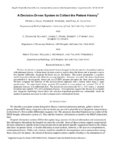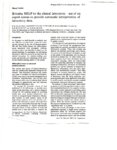Filters: Date: "1987" Collection: "ir_uspace"
| Creator | Title | Description | Subject | Date | ||
|---|---|---|---|---|---|---|
| 1 |
 |
Gopalakrishnan, Ganesh | A compositional model for synchronous VLSI systems | Currently available hardware specification languages have two serious deficiencies: (i) inadequate protocol definition capabilities; (ii) lack of a compositional model. We now explain these in more detail. | Very large scale integration; VLSI systems | 1987 |
| 2 |
 |
Henderson, Thomas C. | A control paradigm for general purpose manipulation systems | Mechanical end effectors capable of dextrous manipulation are now a reality. Solutions to the high level control issues, however, have so far proved difficult to formulate. We propose a methodology for control which produces the functionality required for a general purpose manipulation system. It is... | Manipulation systems | 1987 |
| 3 |
 |
Warner, Homer R. | A Decision-Driven System to Collect the Patient History | Biomedical Informatics | 1987 | |
| 4 |
 |
Lyche, Tom | A note on the Oslo algorithm | The Oslo algorithm is a recursive method for updating the B-spline representation of a curve or tensor product surface when extra knots are added. In the present note the derivation of this method is simplified. | Oslo algorithm; B-spline; Curve product surface; Tensor product surface | 1987 |
| 5 |
 |
Fujimoto, Richard M. | A shared memory algorithm and proof for the alternative construct in CSP | Communicating Sequential Processes (CSP) is a paradigm for communication and synchronization among distributed processes. The alternative construct is a key feature of CSP that allows nondeterministic selection of one among several possible communicants. Previous algorithms for this construct assume... | Shared memory algorithm; Communicating Sequential Processes; CSP | 1987 |
| 6 |
 |
Mathews, V. John | A unified approach to nonparametric spectrum estimation algorithms | Abstract-Different approaches to spectrum estimation can be broadly classified as parametric and nonparametric methods. In the parametric techniques, an underlying model is assumed in the formulation of the spectrum estimation problem and one estimates the parameters of the model. For nonparametric... | 1987 | |
| 7 |
 |
Mathews, V. John | Adaptive filters requiring zero multiplications | This paper introduces an adaptive filter structure that requires zero multiplications for its implementations. The primary input signals are quantized using DPCM and the DPCM outputs are processed by the adaptive filter. The sign algorithm. We show that if the parameters are chosen properly, hardwar... | 1987 | |
| 8 |
 |
Battin, Margaret P. | Age rationing and the just distribution of health care: is there a duty to die? | These lines express a view again stirring controversy: that the elderly who are irreversibly ill, whose lives can be continued only with substantial medical support, ought not to be given treatment; instead, their lives should be brought to an end. It should be recognized, as one contemporary politi... | 1987 | |
| 9 |
 |
Olivera, Baldomero M. | Aminoglycoside effects on voltage-sensitive calcium channels and neurotoxicity | To the Editor: Since ototoxicity and neuromuscular toxicity of aminoglycoside antibiotics are reversed by calcium, 1,2 and presynaptic events appear to be involved in aminoglycoside-induced neuromuscular blockade, 3,4 we suspected a role for voltage-sensitive calcium channels in aminoglycoside neuro... | Conotoxins | 1987 |
| 10 |
 |
Henderson, Thomas C. | An approach to three-dimensional scene databases | Current image database research is concerned for the most part with the encoding and processing of two-dimensional images. However, the most successful approach to computer vision is based on 3-dimensional information, organized as either stacks of 2-D images (e.g., the intrinsic images of Barrow an... | Image databases; Three-dimensional; Scene databases | 1987 |
| 11 |
 |
Flynn, John J. | Antitrust allegory | Justice SPENCER delivered the opinion of the Court. This is a treble damage action under the Sherman Act, 15 U.S.C. § 1 et seq., the only antitrust case of any kind filed in the federal courts in the past two years.1 We take note of the fact that the Attorney General announced a year ago that ni... | John Sherman Widget Co.; Adam Smith Widgets, Inc.; Sherman Act | 1987 |
| 12 |
 |
Henderson, Thomas C. | Apparent symmetries in range data | A procedure for extracting symmetrical features from the output of a range scanner is described which is insensitive to sensor noise and robust with respect to object surface complexity. The acquisition of symmetry descriptors for rigid bodies from a range image was in this case motivated by the ne... | Symmetry descriptors; Range data; Range scanner; Dextrous manipulation systems | 1987 |
| 13 |
 |
Millgram, Elijah | Aristotle on making other selves | There is still a relative paucity of discussion of the views on friendship that Aristotle presents in the Nicomachean Ethics, although some recent work may indicate a new trend. One suspects that this paucity reflects a belief that those views are not very interesting; if true, this witnesses to an ... | Virtue-friendship; Nicomachean Ethics; Non-instrumental friendship | 1987 |
| 14 |
 |
Yaffe, Joanne | Assessing procedural descriptiveness: rationale and illustrative study | Procedural descriptiveness refers to the extent to which the activities defined in a procedure are complete and specific. Procedures used in research or human service that are poorly described raise important questions such as whether the procedures can be replicated or generalized and, in the case ... | Procedural descriptiveness | 1987 |
| 15 |
 |
Williams, Clayton C. | Atomic force microscope-force mapping and profiling on a sub 100-Å scale | A modified version of the atomic force microscope is introduced that enables a precise measurement of the force between a tip and a sample over a tip-sample distance range of 30-150Å. As an application, the force signal is used to maintain the tip-sample spacing constant, so that profiling can be ... | Attractive force; Silicon wafer | 1987 |
| 16 |
 |
Coley, Phyllis D. | Between-species differences in leaf defenses of tropical trees | Rates of herbivory and patterns of leaf defense are presented for light-demanding and shade-tolerant tree species growing in a lowland rainforest in Panama. More than 85 percent of the annual leaf damage is due to grazing by insects. There are over three orders of magnitude difference between specie... | Herbivory; Interspecific variation; Panama; Growth rate; Shade tolerance; Treefall gaps; Tropical forest; Understory; Tannins; Alkaloids | 1987 |
| 17 |
 |
Bernstein, Paul S. | Biochemical characterization of the retinoid isomerase system of the eye | We have previously shown that membranes from the retinal pigment epithelium can transform added all-trans-retinol into a mixture of 11-cis-retinoids, demonstrating the "missing reaction" in the visual cycle for the first time (Bernstein, P. S., Law, W. C., and Rando, R. R. (1987) Proc. Natl. Acad. S... | Hydrogen-Ion Concentration | 1987 |
| 18 |
 |
Olivera, Baldomero M. | Biochemical studies of ω-conotoxin GVIA; a peptide toxin inhibiting voltage-sensitive Ca++ channels | The fish-hunting cone snails use their venom to quickly paralyze their more agile prey. In the last few years, our laboratories have carried out a program of analyzing biologically active components present in the fish-hunting cone snail venoms (Cruz et al. 1985; Olivera et al. 1985). We have concen... | Conotoxins; Calcium channels; Conus geographus; Venom | 1987 |
| 19 |
 |
Mattis, Daniel C. | Bond asymmetry and high-Tc superconductivity | We propose a simple mechanism, anchored in weak-coupling BCS theory, which ties together the following facts: high Tc; quasi two dimensionality; orthorhombic distortion and/or disordered lines of oxygen; proximity to a metal-insulator transition; and anomalously small isotope effects. | Distortion; Singularity; Oxygen | 1987 |
| 20 |
 |
Warner, Homer R. | Bringing HELP to the Clinical Laboratory - Use of an Expert System to Provide Automatic Interpretation of Laboratory Data | Biomedical Informatics | 1987 | |
| 21 |
 |
Hansen, Charles D.; Henderson, Thomas C. | CAD-based robotics | We describe an approach which facilitates and makes explicit the organization of the knowledge necessary to map robotic system requirements onto an appropriate assembly of algorithms, processors, sensor, and actuators. In order to achieve this mapping, several kinds of knowledge are needed. In this ... | CAD-based robotics; CAD-based vision; CAGD System | 1987 |
| 22 |
 |
Hansen, Charles D.; Henderson, Thomas C. | CAGD-based computer vision | Three-dimensional model-based computer vision uses geometric models of objects and sensed data to recognize objects in a scene. Likewise, Computer Aided Geometric Design (CAGD) systems are used to interactively generate three-dimensional models during the design process. Despite this similarity, the... | Computer Aided Geometric Design (CAGD); CAD-based vision; Model based vision; Strategy trees; Geometric knowledge representation; Automatic feature selection | 1987 |
| 23 |
 |
Henderson, Thomas C. | CAGD-based computer vision | Three-dimensional model-based computer vision uses geometric models of objects and sensed data to recognize objects in a scene. Likewise, Computer Aided Geometric Design (CAGD) systems are used to interactively generate three-dimensional models during the design process. Despite this similarity, t... | Computer Aided Geometric Design; CAGD | 1987 |
| 24 |
 |
Bhanu, Bir | CAOS an approach to robot control | Control systems which enable robots to behave intelligently is a major issue in todays process of automating factories. This thesis presents a hierarchical robot control system, a programming language for goal achievement, termed CAOS for Control using Action Oriented Schemata, with ideas taken fro... | Robot control system; CAOS; Control using Action Oriented Schemata | 1987 |
| 25 |
 |
Gelfand, Donna M. | Characteristics of Venezuelan school refusers toward the development of a high-risk profile | Parent, teacher, and child reports were used to identify situational and personal factors associated with school refusal in 114 3- to 13-year-old Venezuelan children. The sample consisted of 57 school refusers and 57 nonrefusers matched on age, school, and sex. As compared with nonrefusers, the refu... | 1987 |
